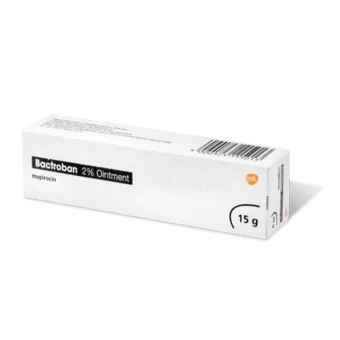Medication features
Bactroban is an antibiotic ointment used in the treatment of nasal infections. It is applied in small amounts directly to the inside of the nostril, usually two to three times per day for a specified period. Bactroban is made by GlaxoSmithKline, and its active ingredient is mupirocin calcium, which works by attacking the bacteria responsible for infection.
- Contains the antibiotic Mupirocin
- Treats several skin conditions
- Short term use only
Overview
What is Bactroban?
Bactroban (also known as mupirocin) is a topical antibiotic used to treat superficial skin infections. These might include impetigo, caused by the bacteria Staphylococcus aureus.
This type of antibiotic will have no effect on fungal or viral skin infections.
While Bactroban is one of the most common brand names of mupirocin, you may also find the ointment labelled as Centany or Centany AT.
Bactroban comes in the form of an ointment or cream.
What Is Bactroban Used For?
Bactroban is used to treat bacterial skin infections. It works by killing bacteria present on the skin, with the aim to prevent future bacterial growth in the same area.
Bactroban is commonly used to treat a skin infection known as impetigo.
Bactroban can also be used to treat open wounds which have subsequently become infected or exposed to bacteria. A GP will often recommend Bactroban as a means of preventing the development of bacteria on the skin for susceptible patients.
Due to its low cost, ease of application and absence of severe side effects, this antibiotic ointment is preferred to most orally administered antibiotics.
How Does Bactroban Work?
Bactroban ointment and cream contain the antibacterial mupirocin.
Mupirocin works by targeting and affecting the bacteria's production of certain proteins necessary for its survival. Instead, it forces the bacteria to produce abnormal and faulty proteins, ultimately killing the bacteria and clearing up the infection.
The patient should see their infection clear up and the area around the skin returns to normal, with some observation being recommended to avoid the infection from returning.
You should not scratch or pick at the infected area before, during or after treatment.
Bactroban vs Bacitracin
Bacitracin is a commonly used cyclic polypeptide antibiotic developed to prevent wound infections, treat pneumonia and empyema in infants, and treat skin and eye infections while alleviating pain and irritation.
Randomised prospective studies of 5-day treatment comparing the two for the elimination of Staphylococcus aureus nasal colonisation showed that after 72 to 96 hours of treatment, the organism was eradicated in 15 (94%) of 16 by mupirocin and in 8 (44%) of 18 by bacitracin (P = .0031).
Similar efficacy was demonstrated at 30 days. Bactroban may be more effective than Bacitracin for the eradication of S. aureus in healthy subjects.
Bactroban vs Fucidin
Fucidin is a type of fusidic acid antibiotic used topically in creams and eye drops. It is also given systemically as a tablet or injection to treat skin infections and irritations.
In light of the global problem of advancing antimicrobial resistance, fusidic acid has experienced a renewed interest.
In studies comparing the two, bacteriologic cure rates were 97% (30 of 31 patients evaluated) in the Bactrodan mupirocin-treated group, compared with 87% (27 of 31 patients evaluated) in the fusidic acid-treated group. No side effects were observed in either treatment group.
Bactroban vs Neosporin
Also known as triple antibiotic ointment, Neosporin is a common medication used to reduce the risk of infections following minor skin injuries. It can also be used to treat superficial bacterial eye infections.
Neosporin contains three antibiotic ingredients: neomycin, polymyxin B, and bacitracin.
Compared to over-the-counter options such as Neosporin, Bactroban has been shown to eliminate a larger variety of bacteria and is a good alternative if you're allergic to certain ingredients in over-the-counter products. It can also further help prevent infection in minor cuts, scrapes, and burns to a greater degree.
Bactroban Reviews
Reviews of Bactroban from real users are largely positive, with patients praising the product for:
- Quick and easy use on everyday infections such as mosquito bites
- Impact on common and long-standing infections
- Affordable pricing
However, some reviews do highlight that Bactroban will not clear up all superficial skin infections and that further consultation with a GP may be needed.
Can I Buy Bactroban Over The Counter?
You cannot buy Bactroban over the counter in the UK. Both Bactroban cream and nasal ointment can only be obtained in the UK with a prescription.
However, you can buy Bactroban online at Cloud Pharmacy using our online doctor service.
Once you’ve completed a short online questionnaire, we can check that Bactroban is the right treatment for you. Then our team of qualified prescribers will be able to issue your prescription.
If your order is approved before 3pm on weekdays, our UK pharmacy can dispatch your item the same day via a next-day delivery service.
Directions
How to Apply Bactroban
Before using Bactroban, thoroughly wash the infected area with soap and water. Then apply to the affected skin softly as a thin layer of film. This may then be covered with a sterile dressing for security.
In the event you miss a dose of Bactroban, it is safe to apply the missed dose as soon as possible.
However, if enough time has passed that you should be applying your next dose instead, simply skip the missed dose and resume your typical application schedule. Never use Bactroban twice in one 24 hour period.
Bactroban should be stored at room temperature and kept away from excess heat and moisture. With this in mind, it is not necessarily best to store it in the bathroom as that is likely to be too moist of an environment, especially if it’s a small bathroom with minimal airflow. Be sure to keep it out of reach of children.
How Long Does Bactroban Take To Work?
Your doctor or pharmacist will be able to give you a timeline of how long to use Bactroban.
You should not stop before this date or the bacteria may survive and the infection may return. It typically takes up to 10 days for the cream and ointment to work, while the nasal ointment works in 5 to 7 days.
Do not use Bactroban beyond these times as you could accidentally develop an infection called thrush (Candida).
In the case the infection does not clear up during this period, contact your doctor for further advice.
Seek medical advice should you swallow the medicine and rinse your eyes thoroughly if contact is made with your eyes.
Side Effects
Bactroban Side Effects
As with any medicine, Bactroban may cause side effects. This doesn’t mean that everyone who uses Bactroban will experience side effects.
These potential side effects should always be considered before taking Bactroban, especially if you have an underlying health condition, are recovering from an illness or are planning to drive a vehicle/operate machinery.
Common, and largely harmless side effects of Bactroban include:
- Experiencing diarrhoea (sometimes severe and for long periods)
- Burning, stinging, and pain local to the application site
If you typically experience diarrhoea, be aware that this symptom has been worsened through the use of Bactroban. Diarrhoea may occur several months after the use of Bactroban is discontinued. In this case, be sure to consult your healthcare provider regarding the best line of treatment.
Less common side effects include:
- Skin changes to the application site
- Intense blistering
- Irritation
- Reddening
- Cracking and dryness of the skin
Occasionally, patients will experience less common side effects are swelling, tenderness, and warmth to the skin along with sores and ulcers in or around the mouth.
If you experience severe side effects or allergic reactions, contact a medical professional or call 999 immediately.
Patient Information Leaflet
Bactroban Patient Information Leaflet
For more information on Bactroban, visit the patient information leaflet below:
Bactroban 2% Cream & Ointment Reviews
Confirm Bactroban 2% Cream & Ointment treatment selection
| Ointment | 15g | £14.99 |
| Nasal Ointment | 3g | £14.99 |
| Cream | 15g | £14.99 |
















